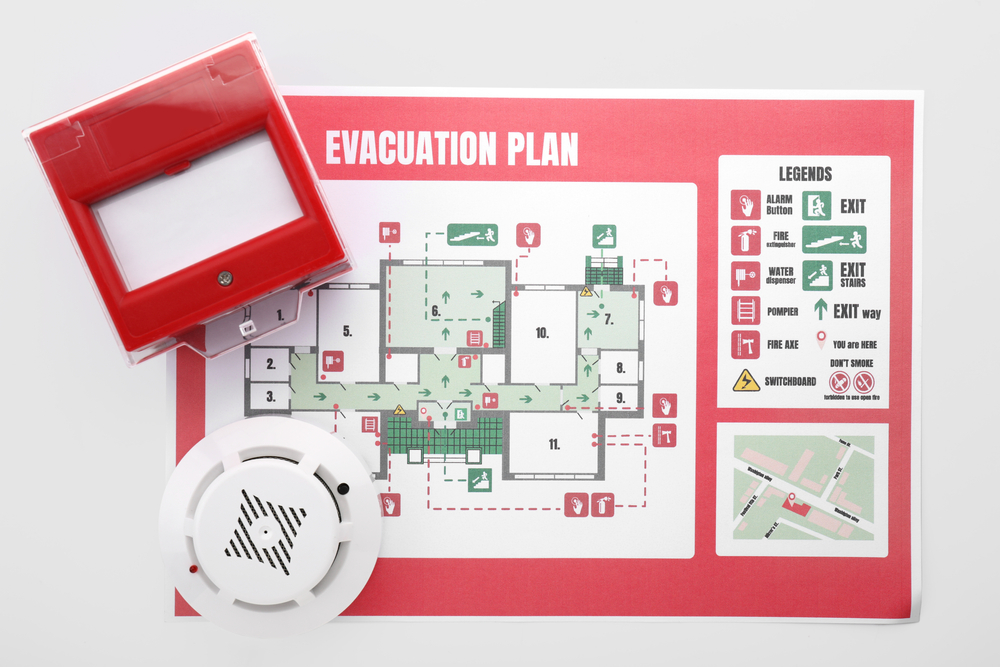As a business owner, it’s essential that you and your staff are on the same page when it comes to what happens in the event of a fire in the workplace.
In order to be able to communicate the procedures effectively, all business owners must work to put together a detailed and thorough plan of what all employees are expected to do should a fire ever occur.
Putting together a detailed and well thought-out fire evacuation plan for your business is crucial to ensuring the safety of yourself, your team and any visitors within the building, so it should be at the top of your priority list. However, there’s plenty to cover and lots at stake, so we can understand how it may prove a little overwhelming.
To help you keep your employees, visitors and business protected, here’s our guide to putting together a fire evacuation plan for your business.
What Should Be Included In A Fire Evacuation Plan?
At the very least, your fire evacuation plan should cover the following:
- Details of where your building’s fire call points are located, so that employees understand how to quickly raise the alarm in the event that they discover a fire in the building
- Procedure for identifying and communicating false alarms
- A clear directive of who is responsible for calling 999 and alerting emergency services
- Clear information identifying the closest escape routes to different areas of the building, ensuring each is a suitable escape route and leads to a designated fire exit
- Locations of the fire exit doors around the building (the routes to these doors should always be indicated using clear signage)
- Evacuation procedures for staff or visitors who may not be able to evacuate as quickly, such as wheelchair users, the elderly and the visually impaired – all commercial environments with stairs inside should be equipped with EvacChairs.
- A designated meeting point for all staff
If you come to make your plan and find that you are unable to cover any of these bases – for example, you are unsure of the most efficient escape routes or have not appointed fire marshals – then you must make these changes before you continue.
Further Points For Consideration
Depending on the size and nature of your business, there may be more detail or further information needed in your fire procedure plan in order to make sure it’s as thorough as possible.
Further points for consideration include:
- What an employee is expected to do on discovering a fire or being alerted to a fire by a customer
- Where extinguishers are located within the building, should an employee feel confident that the fire is small enough to be extinguished this way
- How to communicate the situation to customers or visitors
- A clear directive of what is expected of staff members in the event of a fire – fire marshals, roll calls, etc.
Again, these will vary depending on whether or not your business serves members of the public or is simply a place of work.
How Should I Communicate My Completed Plan To My Staff?
Fire evacuation plans should be communicated thoroughly to staff as a part of their fire safety training, which all business owners must ensure is carried out for all employees at least once each year, with updated training given in the event that there are any changes.
Due to the importance of all staff understanding the fire evacuation plan, we recommend that all staff must read the plan for themselves and be asked to confirm clearly that they understand the procedures. This is best done by having staff sign a document to declare their understanding of the procedures and that they have received a sufficient level of training to be able to follow the plan correctly.
Your plan should also be easy for staff to access in case they need to be reminded of the procedures. We recommend that a plan is kept somewhere safe or shared digitally to employees so that it can be available to staff who express a need to re-read it. You may also hand out physical copies to your team, depending on your number of employees.
How Often Do I Need To Update My Fire Evacuation Plan?
Your fire evacuation plan should be regularly updated in accordance with changes at your business.
For example, if a designated fire marshal leaves their position at your workplace, a new one must be appointed in their place. If a designated escape route is no longer available to use, it must be removed from your plan.
Again, these changes should always be communicated to your employees when they happen.
How Can I Get Help In Putting Together My Business’ Emergency Fire Procedures?
At Safe & Sound, we do everything that we can to assist businesses across Glasgow and Edinburgh in ensuring that their businesses are fully prepared to deal with a workplace fire.
This includes offering staff training, the installation of passive fire protection, alarms and fire extinguishers, carrying out thorough fire safety risk assessments and much more.
If you would like our assistance in ensuring that your business is fire-safe, get in touch today and ask for more information about our services.

